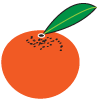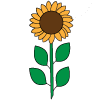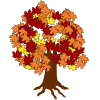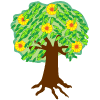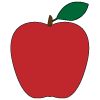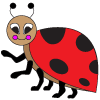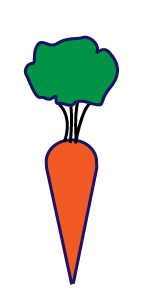- Carrots are a root vegetable, usually orange in colour, though purple, red, white, and yellow varieties exist.
- The most commonly eaten part of a carrot is a taproot, although the greens are edible as well.
- It is a domesticated form of the wild carrot Daucus carota, native to Europe and southwestern Asia.
- It is a biennial plant which grows a rosette of leaves in the spring and summer, while building up the stout taproot,
which stores large amounts of sugars for the plant to flower in the second year.
- Only 3% of the β-carotene in raw carrots is released during digestion: this can be improved to 39% by pulping, cooking and adding cooking oil.
- Together with onion and celery, carrots are one of the primary vegetables used in a mirepoix to make various broths.
- In India carrots are used in a variety of ways, as salads or as vegetables added to spicy rice or daal dishes.
- The most popular variation in north India is the Gaajar Kaa Halwaa carrot dessert, which hascarrots grated and cooked in milk until the whole mixture is solid, after which nuts and butter are added.
- Carrot salads are usually made with grated carrots in western parts with a seasoning of mustard seeds and green chillies popped in hot oil, while adding carrots to rice usually is in julienne shape.
- The variety of carrot found in north India is rare everywhere except in Central Asia and other contiguous regions, and is now growing in popularity in larger cosmopolitan cities in SouthIndia.
- Since the late 1980s, baby carrots or mini-carrots (carrots that have been peeled and cut into uniform cylinders) have been a popular ready-to-eat snack food available in many supermarkets.
- Carrot juice is also widely marketed, especially as a health drink, either stand-alone or blended with fruits and other vegetables.
- Carrots are useful companion plants for gardeners.
- In addition to wild carrot, these alternative (mostly historical) names are recorded for Daucus carota: bee’s-nest, bee’s-nest plant, bird’s-nest, bird’s-nest plant, bird’s-nest root, carota, carotte (French), carrot, common carrot,
crow’s-nest, daucon, dawke, devil’s-plague, fiddle, gallicam, garden carrot, gelbe Rübe (German), gingidium, hill-trot, laceflower, mirrot, Möhre (German), parsnip (misapplied), Queen Anne’s lace, rantipole, staphylinos, and zanahoria (Spanish).
- The carrot gets its characteristic and bright orange colour from β-carotene, which is partly metabolised into vitamin A in humans.
- The legend arose during the Battle of Britain when the RAF circulated a story about their pilots’ carrot consumption as an attempt to cover up the discovery and effective use of radartechnologies in engaging enemy planes, as well as the use of red light (which does not destroy night vision) in aircraft instruments.
- Carrot cultivars can be grouped into two broad classes, eastern carrots and western carrots.
- Specimens of the eastern carrot that survive to the present day are commonly purple or yellow, and often have branched roots.
- The purple colour common in these carrots comes from anthocyanin pigments.
- The western carrot emerged in the Netherlands in the 17th century, from Iran with violet colur, its orange colur making it popular in those countries as an emblem of the House of Orange and the struggle for Dutch independence.
|
|
WEBBY WANDA DRAWING TIPS:
What Are Conte Crayons?
.
Conté crayons
Page from a sketchbook using black Conté crayon.
Conté, also known as Conté sticks or Conté crayons, are a drawing medium composed of compressed powdered graphite or charcoal mixed with a wax or clay base, square in cross-section. They were invented in 1795 by Nicolas-Jacques Conté, who created the combination of clay and graphite in response to the shortage of graphite caused by the Napoleonic Wars (the British naval blockade of France prevented import). Conté crayons had the advantage of being cost-effective to produce, and easy to manufacture in controlled grades of hardness.
They are now manufactured using natural pigments (iron oxides, carbon black, titanium dioxide), clay (kaolin), and a binder (cellulose ether).[1]
Conté crayons are most commonly found in black, white, and sanguine tones, as well as bistre, shades of grey, and other colors. Currently in the USA, sets of 12 assorted, portrait and landscape colors are available as well as a sketching set, plus sets of 18, 24 or 48 colors. In Europe, 22 more colors are available and the colors other than sanguine, bistre, grey, black and white are available open stock.
Colors sets are especially useful for field studies and color studies. Some artists create entire paintings with them, using them more like pastels than like a drawing medium. They are also used often to sketch under pastel paintings or lay down initial layers before using dry pastels. The "colors" sets lean toward very bright spectrum hues that mix well, even the 12 assorted color set can be layered to produce any hues or values desired. Color Conté mixes better on paper than many hard pastel products.
They are frequently used on rough paper that holds pigment grains well. They can also be used on prepared primed canvases for underdrawing for a painting. The sticks' square profile make Conté crayons more suitable for detailed hatched work as opposed to the bolder painterly drawing style demanded by soft pastels.
Reference From Wikipedia, the free encyclopedia
For other uses, see Conté (disambiguation)
|





